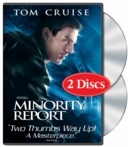|
|
DVD Review: Minority ReportBy Glenn Abel |
|
|
 "Is it now?" a dazed seer asks Tom Cruise's rogue cop in
"Minority Report." Viewers may well wonder the same thing during the sensational
DVD presentation of Steven Spielberg's futuristic film noir.
"Is it now?" a dazed seer asks Tom Cruise's rogue cop in
"Minority Report." Viewers may well wonder the same thing during the sensational
DVD presentation of Steven Spielberg's futuristic film noir.
The movie itself coolly transports viewers to a world 52 years ahead -- Spielberg's paranoid vision of life in the nation's capital seems not only possible, but probable at times. Then there are the filmmaking techniques demonstrated on the DVD by the director's effects visionaries -- so cutting-edge and visually startling that they seem right out of the movie itself. Take, for example, the scene in which the police's spider-like droids search a squalid apartment building. We see how Industrial Light + Magic used its computers not only to create the metallic "spyders," but to develop their personalities and communication methods. Moving 3-Dcq storyboards from the Pixel Liberation Front showed cinematographer Janusz Kaminski where to place his cranes, cameras and lights in order to pull off the near-impossible omniscient view of the raid. ("It was not that much fun to do," the Oscar-winning DP grouses.) Cruise, for one, was suitably impressed with this brave new world of filmmaking. "I've never done anything like that before," he marvels. DreamWorks Home Entertainment has released "Minority Report" in a two-disc set, available either in widescreen or full screen (retail $29.99). The first disc (dual layer) contains only the film, no director's commentary. Director Spielberg has his say on the second (single layer) disc, which has a generous selection of bonus materials that are well organized and to the point. The menus have the nightmarish look of the "precog" visions that the film's cops use to predict and halt murders. Kaminski's otherworldly color scheme -- achieved via an unconventional "bleach bypass" on the negative stock -- comes across with all of its unsettling power. Blacks seem devoid of light, full of despair. The cobalt blues saturate the images, evoking the specter of a locked-and-loaded police state. The widescreen presentation (2.35:1) amplifies Kaminski's odd-angle noir compositions; the full-screen rendition (1.33:1) feels capably done, but much is lost in dramatic emphasis. The DTS and Dolby Digital 5.1 sound are typical of Spielberg's DVDs, with an up-front bias and subdued directional effects. The chilling subwoofer bottom keeps listeners on edge. The featurette compilation opens and closes with Spielberg and Cruise exchanging superlatives (the package actually has a beginning, middle and end). Spielberg talks about how "A.I." and "Minority Report" fit into his midlife vision quest. The director explains his "dirty, ugly" take on the future of U.S. society. "The most frightening thing to me is that George Orwell's prophecy really comes true -- not in the 20th century, but in the 21st," Spielberg says of "Minority Report." "What little privacy we have now will be completely evaporated in 20 or 30 years. ... Everything will be 'identified.' " Wisely, most of the extras focus on the effects wizards and craftsmen who realized this future world. DVD content specialist Laurent Bouzereau keeps the featurettes moving along, with little time for the specialists to become tangled up in their thoughts. Fast-paced editing keeps the screen shots and on-set clips fresh. The breakdown of the holography sequences is of particular interest, with some truly bizarre production-software images. The oft-interviewed folks at ILM seem quite at home in front of the camera these days, breaking down some of the 481 effects shots. Production designer Alex McDowell tells how his sets of glass and metal mirrored the film's theme of distorted vision. For buildings, "We looked at the architects who are pushing the envelope right now." The vehicle builders were kept busy with the "Mag-Lev" autos and the 28-foot hovercraft, "a futuristic version of the Hindenberg" inspired by a peek at the Air Force's real thing. Weapons such as the sonic-boom gun and "sick stick" were byproducts of a think tank that Spielberg hosted during story development. Costume designer Deborah Scott tells how she created a "second skin" for the floating "precog" seers. For police uniforms, she drew inspiration from "The Right Stuff," seeking a rugged but still futuristic look that wouldn't seem dated in five years. Music man John Williams marvels at the idea of a film noir set in the future, oddly ignoring "Blade Runner" (another visionary film based on a Philip K. Dick short story). "Minority Report" feels like "a Humphrey Bogart film," Williams says in explaining why he rejected synthesized sounds. He notes that Spielberg's touches of sentimentality among the grunge "would never be permissible" in film noir. Kaminski also has interesting things to say about noir and its "certain language." The disc offers show-and-tell on such key scenes as the Hall of Containment, the jet-pack fight and the auto-plant chase. A chapter dedicated to stunts features footage of Cruise doing his own work against the giant blue screen. An "archives" section holds down the clutter by segregating the expected DVD fare of trailers, production notes and storyboards. Extensive "production concepts" cover designs for everything from the hovercraft to greenhouse plants. Glenn Abel is Executive Editor, Electronic, at The Hollywood Reporter Reprinted, with permission, from The Hollywood Reporter

| Sell-Through | Reviews | Links | Widescreen |
© 1998, 1999, 2000, 2001, 2002 OnVideo. All rights reserved (ISSN 1094-3676). |